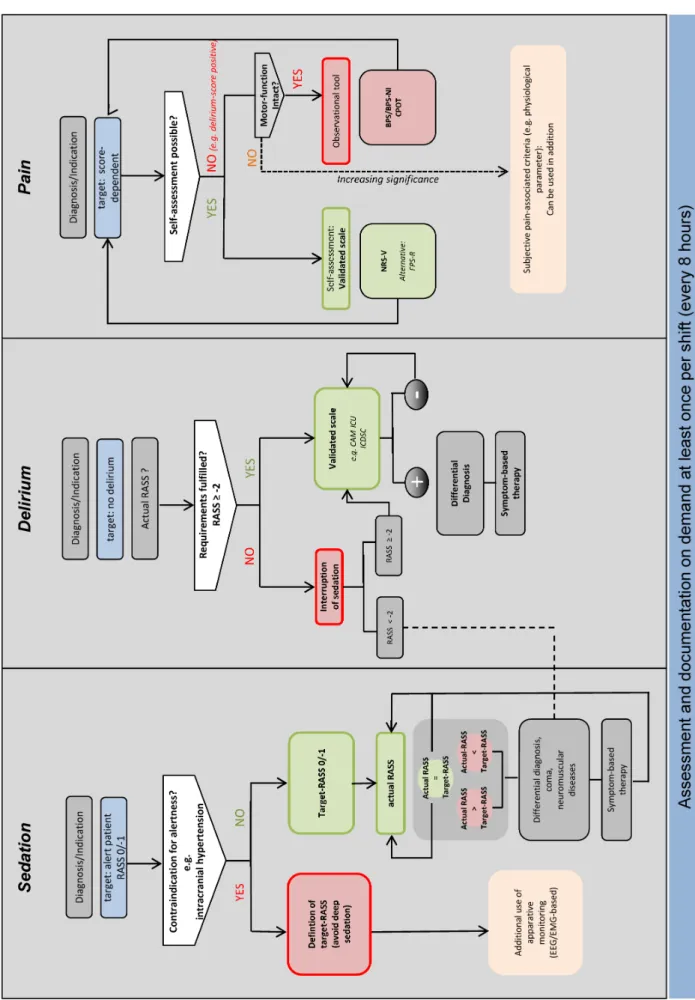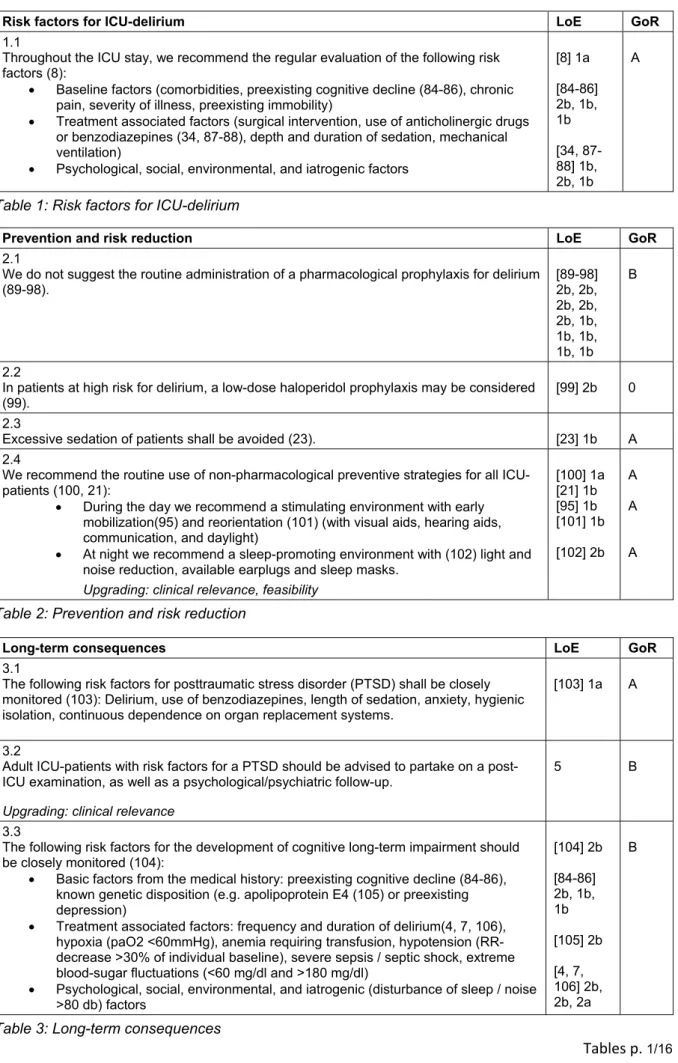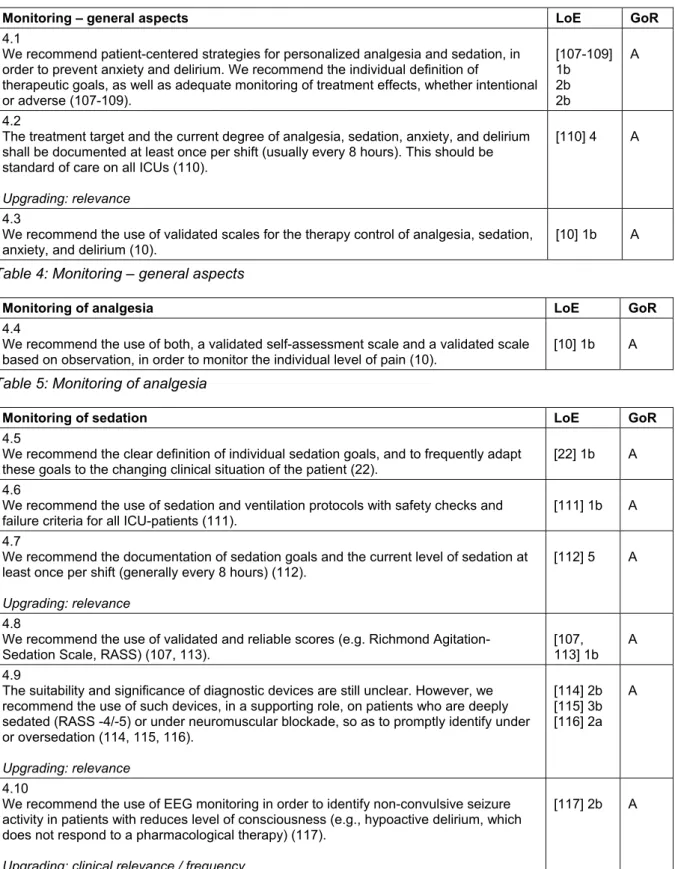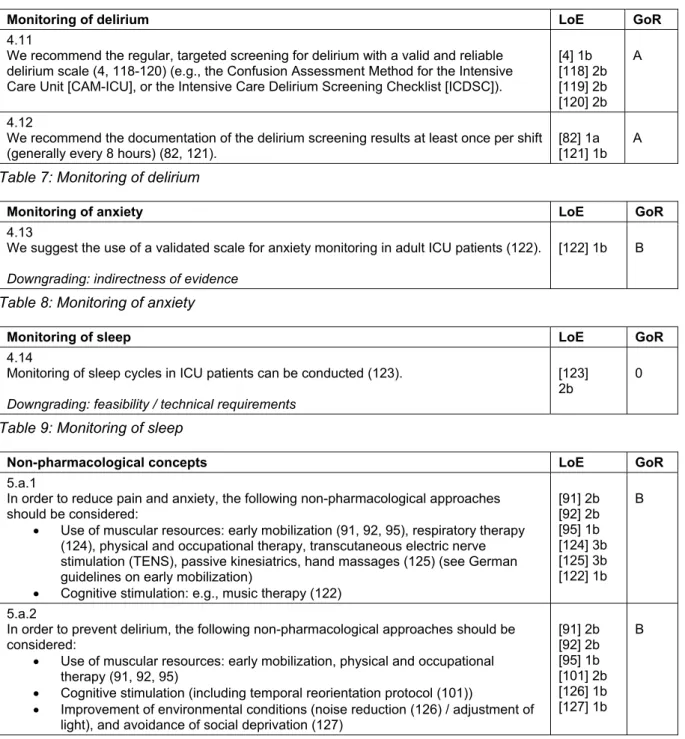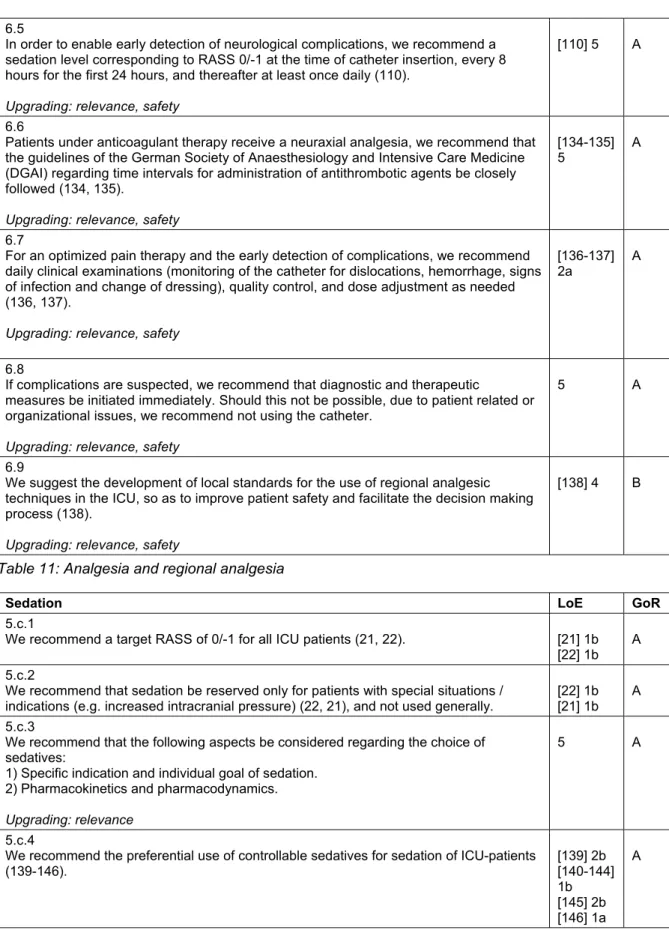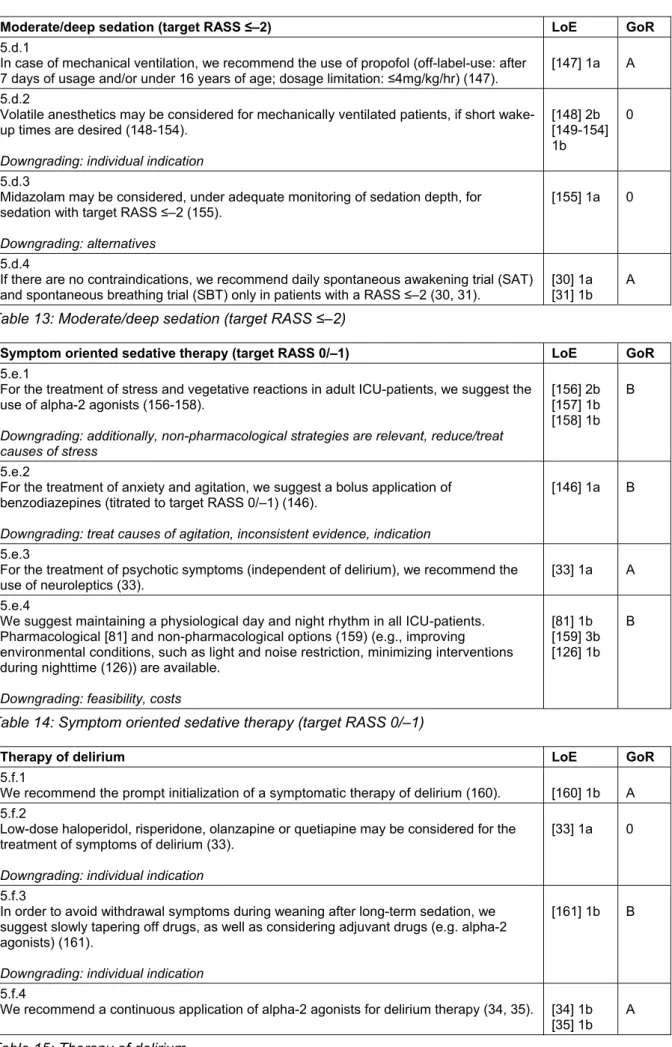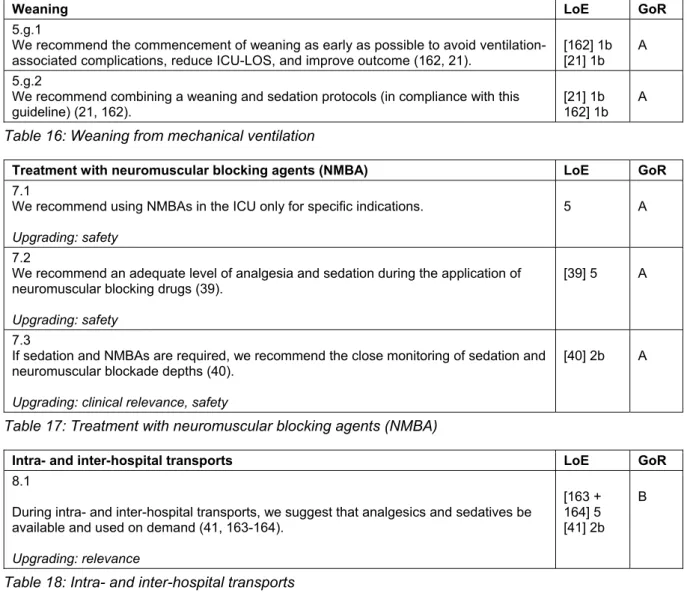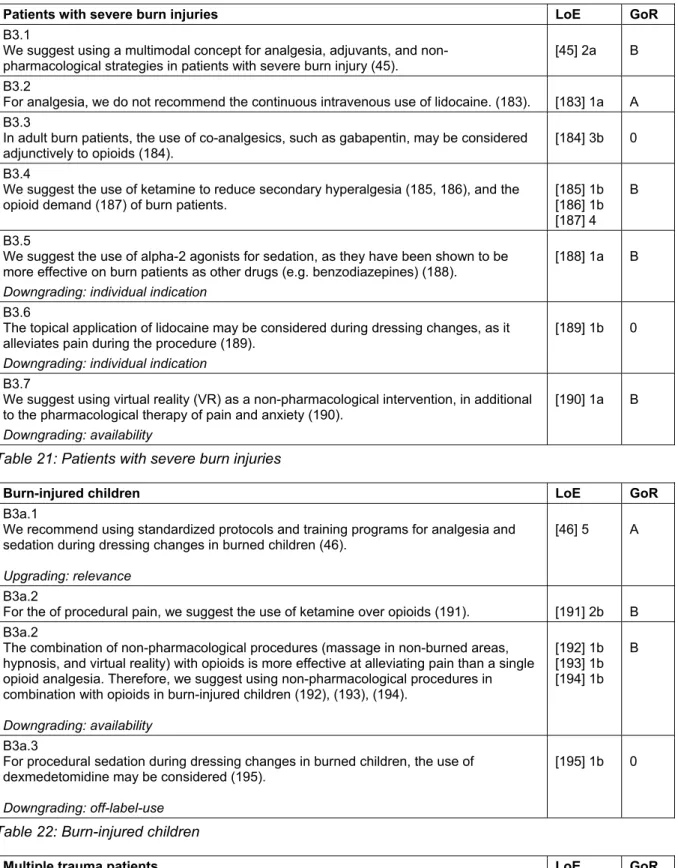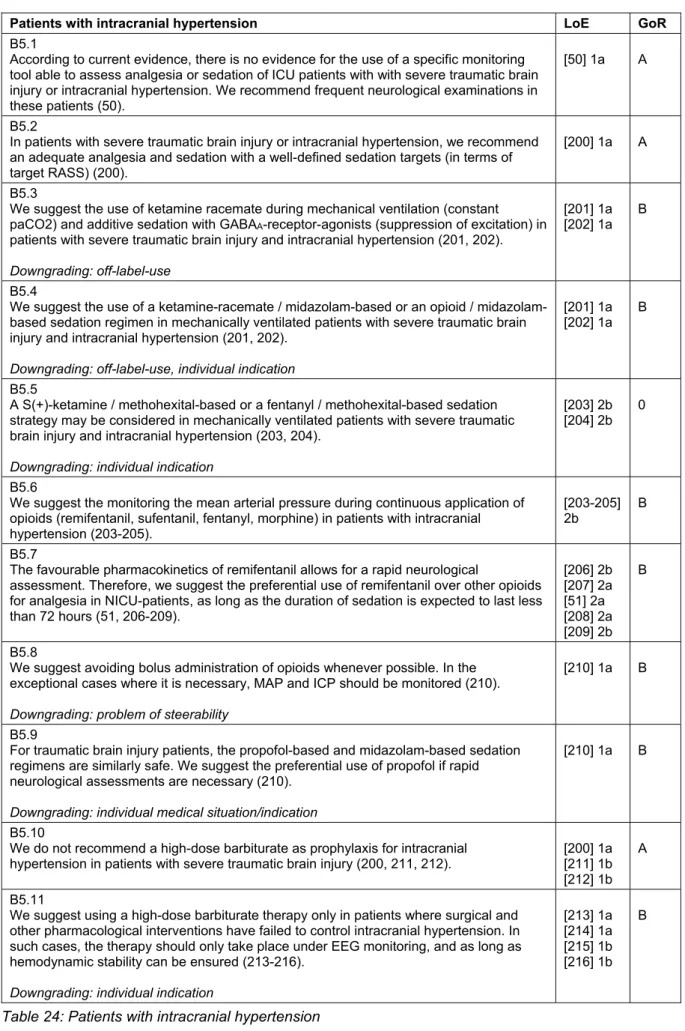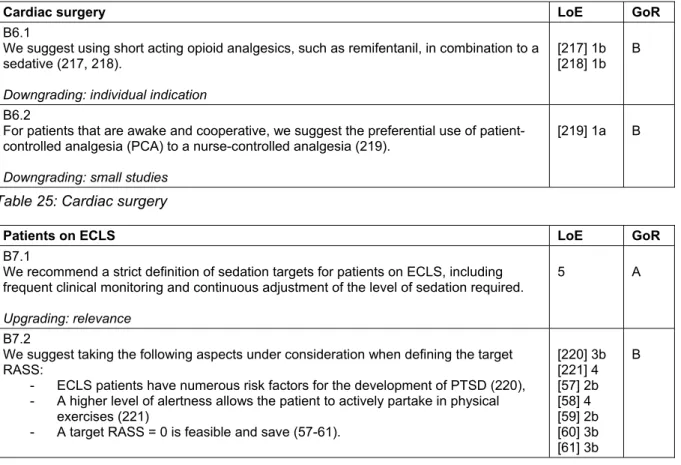Evidence and consensus based guideline for the
management of delirium, analgesia, and sedation in intensive care medicine. Revision 2015 (DAS-Guideline 2015) – short version
Abstract
In 2010, under the guidance of the DGAI (German Society of Anaesthesi- ology and Intensive Care Medicine) and DIVI (German Interdisciplinary
DAS-Taskforce 2015 : Ralf Baron
1Association for Intensive Care and Emergency Medicine), twelve German
Andreas Binder
1medical societies published the “Evidence- and Consensus-based
Rolf Biniek
1Guidelines on the Management of Analgesia, Sedation and Delirium in
Intensive Care”. Since then, several new studies and publications have Stephan Braune
2considerably increased the body of evidence, including the new recom-
Hartmut Buerkle
3mendations from the American College of Critical Care Medicine (ACCM)
Peter Dall
4in conjunction with Society of Critical Care Medicine (SCCM) and
American Society of Health-System Pharmacists (ASHP) from 2013. For Sueha Demirakca
5this update, a major restructuring and extension of the guidelines were
Rahel Eckardt
6needed in order to cover new aspects of treatment, such as sleep and
Verena Eggers
3anxiety management. The literature was systematically searched and
evaluated using the criteria of the Oxford Center of Evidence Based Ingolf Eichler
7Medicine. The body of evidence used to formulate these recommenda-
Ingo Fietze
8tions was reviewed and approved by representatives of 17 national
Stephan Freys
9societies. Three grades of recommendation were used as follows: Grade
“A” (strong recommendation), Grade “B” (recommendation) and Grade Andreas Fründ
10“0” (open recommendation). The result is a comprehensive, interdiscip-
Lars Garten
5linary, evidence and consensus-based set of level 3 guidelines. This
Bernhard Gohrbandt
7publication was designed for all ICU professionals, and takes into ac-
count all critically ill patient populations. It represents a guide to symp- Irene Harth
5tom-oriented prevention, diagnosis, and treatment of delirium, anxiety,
Wolfgang Hartl
9stress, and protocol-based analgesia, sedation, and sleep-management
in intensive care medicine. Hans-Jürgen Heppner
6Keywords: guideline, evidence, analgesia, sedation, delirium, anxiety, stress, sleep, monitoring, treatment, intensive care, critical care, Germany
Johannes Horter
3Ralf Huth
5Uwe Janssens
2Christine Jungk
11Kristin Maria Kaeuper
12Paul Kessler
3Stefan Kleinschmidt
3Matthias Kochanek
13Matthias Kumpf
5Andreas Meiser
3Anika Mueller
3Maritta Orth
8Christian Putensen
3Bernd Roth
5Michael Schaefer
14Rainhild Schaefers
121/42 GMS German Medical Science 2015, Vol. 13, ISSN 1612-3174
Guideline This is the original (English) version.
The translated (German) version starts at p. 22.
OPEN ACCESS
Intensive Care Medicine
Peter Schellongowski
13Monika Schindler
5Reinhard Schmitt
15Jens Scholz
3Stefan Schroeder
16Gerhard
Schwarzmann
15Claudia Spies
3Robert Stingele
1Peter Tonner
3Uwe Trieschmann
3Michael Tryba
3Frank Wappler
3Christian Waydhas
17Bjoern Weiss
3Guido Weisshaar
51 German Society of Neurology (DGN)
2 German Society of Internal Medicine Intensive Care (DGIIN)
3 German Society of Anaesthesiology and Intensive Care Medicine (DGAI)
4 German Society of Gynecology & Obstetrics (DGGG)
5 German Society of Neonatology and Pediatric Intensive Care (GNPI) 6 German Society of
Geriatrics (DGG)
7 German Society for Thoracic and Cardiovascular Surgery (DGTHG)
8 German Sleep Society (DGSM)
9 German Society of Surgery (DGCH)
10 German Association for Physiotherapy (ZVK) 11 German Society of
Neurosurgery (DGNC) 12 German Society of
Midwifery Science (DGHWi) 13 German Society of
Haematology and Oncology (DGHO)
2/42 GMS German Medical Science 2015, Vol. 13, ISSN 1612-3174
DAS-Taskforce 2015 et al.: Evidence and consensus based guideline for the management ...
14 German Pain Society (DGSS)
15 German Society for Specialised Nursing and Allied Health Professions (DGF)
16 German Association for Psychiatry, Psychotherapy and Psychosomatics (DGPPN)
17 German Interdisciplinary Association for Intensive Care and Emergency Medicine (DIVI)
Introduction
In 2010, twelve German medical societies published the Evidence- and Consensus-based Guidelines on the Management of Analgesia, Sedation and Delirium. Since this publication, the body of evidence in the field has in- creased considerably. Several new studies and publica- tions, including the new recommendations from the American College of Critical Care Medicine (ACCM) in conjunction with Society of Critical Care Medicine (SCCM) and American Society of Health-System Pharmacists (ASHP) in 2013, make a substantial actualization of the German guidelines necessary. This update not only ac- counts for new evidence, but also contains a major re- structuring and extension of the guidelines to cover new aspects of treatment, such as sleep and anxiety manage- ment.
This new version aims to provide practical guidance for the symptom-based prevention, diagnostics and therapy of delirium, anxiety, and agitation, as well as for the pro- tocol-based analgesia, sedation, and sleep management during critical illness. Under the guidance of the German Society of Anaesthesiology and Intensive Care Medicine (DGAI) and German Interdisciplinary Association for In- tensive Care and Emergency Medicine (DIVI), this is one of the most comprehensive guidelines worldwide, being developed and approved by 17 national societies.
These guidelines were developed for all professions working in the intensive care unit (ICU), and its recom- mendations encompass critically ill patients of all age groups and severity of illness, regardless of comorbidities.
Delirium and coma are the most common manifestations of acute brain dysfunction during critical illness. Pain, stress, and a disruption of the sleep-wake-cycle are typical symptoms observed during ICU treatment, all of which can lead to delirium and impair outcome. An early man- agement of these symptoms improves recovery and long- term outcome, while reducing post-intensive-care-unit- syndrome (PICS) and mortality. The basic principle follows an “early goal directed therapy” (EGDT) with immediate
and evidence-based targets for treatment, the assess- ment of the clinical situation with validated instruments, and the goal-directed pharmacological therapy. These measures are to be accompanied by non-pharmacological interventions aimed at prevention and treatment.
The critically ill patient should be awake and alert, without pain, anxiety, or delirium. Ultimately, this allows the patient to actively participate in their treatment and recovery.
The term “sedation” was left in the title intentionally: the indication and conduction of sedation require special at- tention in order not to harm the patient through oversed- ation, as this has been proven to negatively affect patient outcome. In the interest of the patients, the use of seda- tives and analgesics must therefore be very carefully considered. The patient must be allowed to be as alert and oriented as possible, so that they may partake in the therapy and convalescence process, as evidence shows is feasible, practical, and safe.
Methods
This guideline has the highest development credentials, S3, indicating that it is both evidence- and consensus based. The guideline task-force consisted of 49 voting members nominated by 17 participating national socie- ties. These members formed work groups that identified main clinical issues and framed key-questions to be ad- dressed. Should previous versions of the guideline not /no longer provide satisfactory resolutions to the selected topics, search strategies were developed to address the subject. The resulting recommendations were then col- lected in an early version and further discussed within the groups. The members interacted with each other via consensus-conferences, email, fax, or mail. Communica- tion was managed by a coordinating group consisting of 4 members, as well as the chairing societies. A systematic literature search was performed by a special team under the supervision of an epidemiologist. Finally, the evalu-
3/42 GMS German Medical Science 2015, Vol. 13, ISSN 1612-3174
DAS-Taskforce 2015 et al.: Evidence and consensus based guideline for the management ...
ation process was done by the individual working groups, which also set the level-of-evidence (LoE). All searches were performed between April and May of 2014. When necessary, new evidence was integrated manually. The LoE was determined, as in the previous version of the guideline, using the Oxford System [1]. The overview tables allow to identification the evidence for each indi- vidual manuscript. Literature was accessible for all task- force members. The specific search strategies, searched terms, inclusion and exclusion criteria, as well as exact time frames, are all detailed in the methodological report.
Sources were electronic databases (Medline
®), guideline networks, and (manually) abstracts and congress-publi- cations. In order to identify “grey literature”, all task-force members were asked to search for publications outside Medline and Embase and include relevant entries to the literature-data-base. Systematic guideline searches were conducted within the AWMF-registry (http://www.awmf.
org/leitlinien.html) and the Guidelines International Net- work (G-I-N) (http://www.g-i-n.net). In line with the AWMF- guideline developer manual, a consensus-based decision was used to assess whether recommendations from other guidelines could be adapted. Cultural adaptions were adopted in accordance with recommendations from the ADAPTE-Collaboration [2].
Voting only took place following a full disclosure of poten- tial conflicts of interest by the task-force members. The conflict of interest forms were stored centrally, and all task-force members declaring a conflict of interest were required to abstain from voting in the corresponding is- sues. This was consented in the task-force before the voting process. The voting-process itself was conducted during consensus-conferences, under the supervision of an independent observer from the AWMF. Alternatively, members could vote using an online DELPHI, as published and recommended in the AWMF-guideline developer manual. The used grades of recommendation (GoR) were A = strong recommendation (we recommend/one shall), B = recommendation (we suggest/one should), and O = open recommendation (one might consider) for or against any specific intervention. Significant deviations between LoE and GoR were generally possible if a member of the group requested upgrading or downgrading of a recom- mendation (e.g. due to ethical relevance or lack of re- search-possibilities). Expert opinions and consensus- based decisions were only allowed when the resolutions were highly relevant for clinical routine and there was lack of available evidence.
The guideline was reviewed and approved by 17 scientific societies. Reviewers were all independent peers.
All procedures are in adherence to the actualization pro- tocol. The next regular update of the guideline is sched- uled for 2018, although earlier modifications are permit- ted should significant new evidence arise.
Management of delirium,
analgesia, and sedation in adult intensive care
Risk and prevention of ICU related delirium
Pain, stress, anxiety, and a disrupted sleep-wake cycle are common symptoms that occur in critically ill patients that increase the risk for ICU related delirium [3]. Delirium is one of the most common manifestations of cerebral dysfunction in critically ill patients, which affects not only short-term recovery (in terms of prolonged ventilation and length of stay, as well as increased mortality) [4], [5], [6], but also leads to cognitive long-term impairment, posttraumatic stress disorders (PTSD), and reduced quality of life [7]. These entities are part of the Post In- tensive Care Unit Syndrome (PICS) that has been recently described in ICU survivors.
Aside from managing the risk factors, several effective pharmacological and non-pharmacological prevention strategies can be used to prevent or treat ICU delirium.
In addition to baseline factors, the risk for delirium also comprises treatment associated factors, as well as psy- chological, social, and iatrogenic aspects [8].
The presence or development of risk factors for delirium shall be closely evaluated in order to ensure the prompt introduction of preventive measures. The non-pharmaco- logical measures were shown to be particularly effective in the prevention of delirium, and shall therefore be im- plemented for all critically ill patients.
The excessive use of sedation shall be avoided, since a deep sedation were shown to deteriorate the clinical outcome [9]. A pharmacological prevention is to be re- served only for patients at high risk for delirium, and is not generally recommended (Table 1–3).
[All the tables are displayed following the (English) version of the article.]
Monitoring of analgesia, sedation, delirium, anxiety, stress, and sleep
A basic concept of patient-oriented therapy in intensive- care is the definition of a patient-specific treatment goal, and the frequent assessment of the current status in or- der to promptly introduce or adjust interventions (Goal Directed Therapy). The definition and monitoring of treatment goals must be symptom-oriented, using valid- ated scores and instruments. The use of such validated methods has a major impact on treatment: the systematic evaluation of pain, sedation, and delirium can significantly improve treatment of pain, reduce nosocomial infections, decrease duration of mechanical ventilation and hospital- ization, as well as reduce mortality [10], [11].
Therefore, it should be a standard in all ICUs to define goals, measure, and document the current state of anal- gesia, sedation, and delirium once per shift (usually every
4/42 GMS German Medical Science 2015, Vol. 13, ISSN 1612-3174
DAS-Taskforce 2015 et al.: Evidence and consensus based guideline for the management ...
Figure 1: Algorithm for monitoring of sedation, delirium, and pain in adult patients
RASS: Richmond Agitation, Sedation Scale; CAM-ICU: Confusion Assessment Method for the Intensive Care Unit; ICDSC: Intensive Care Delirium Screening Checklist; BPS: Behavioral Pain Scale; BPS-NI: Behavioral Pain Scale, not intubated; CPOT: Critical Care
Pain Observation Tool; FPS-R: Faces Pain Scale, revised
5/42 GMS German Medical Science 2015, Vol. 13, ISSN 1612-3174
DAS-Taskforce 2015 et al.: Evidence and consensus based guideline for the management ...
8 hours) with a validated clinical scores and instruments (Figure 1).
The evaluation of anxiety with a validated scale is desir- able, since anxiety is often not properly estimated, and thus not properly treated. There are short versions of standard psychological measurement instruments avail- able (State-Trait Anxiety Inventory, state subscale [STAI-s], Brief Symptom Inventory Anxiety, subscale [BSI-A]) that allow a valid and reliable assessment of anxiety. From pain assessment, we know that one-dimensional self- assessment scales have proven to be especially practical to measure therapeutic needs and therapeutic response.
From pain assessment studies, it is clear that the use one-dimensional self-assessment scales are particularly useful in evaluating the therapeutic needs and therapeut- ic response. Studies on anxiety show that similar scales (for example linear Visual Analogue Scale and the Faces Anxiety Scale) are also suitable to measure anxiety with good diagnostic validity [12]. Further studies are needed to clarify whether the controllability of anxiolysis can also be monitored with these scales.
Stress and disturbances of the sleep-wake cycle are fur- ther syndromes in ICU-patients that not only negatively affect recovery, but also constitute risk factors for serious complications. Nevertheless, there are currently no valid- ated routine instrument for measuring stress and sleep, and the sole subjective assessment of vital signs by the ICU personnel is not suitable to monitor stress in critically ill patients [13]. Regarding the sleep-wake cycle of ICU patients, not only is there a lack of suitable monitoring procedures that can be routinely used, but also no valid evaluation of sleep stages in critically ill subjects [14]
(Table 4–9).
Treatment concepts
See Figure 2.
Non-pharmacological concepts
See Table 10.
Analgesia
ICU-patients require an individualized pain management.
Pain exerts considerable negative effects on recovery and is one of the most commonly reported stressors for ICU-patients. Therefore, a sufficient analgesia in all ICU patients – regardless of indication of sedation – should be ensured, and potentially painful procedures should be met with a preventive analgesic approach. In the ICU, the analgesia regimen is usually opioid based [15], [16], [17], [18], as the risk-benefit profile of non-opioid anal- gesics is still a matter of scientific discussion (low anal- gesic potential, but considerable side effects).
A combination with regional analgesia can be used [19], and a patient-controlled analgesia is recommended as soon as the patient is sufficiently awake (RASS 0/-1 and no delirium) [20] (Table 11).
Sedation
The current evidence reveals that a measurable sedation should always be avoided, as long as there is no mandat- ory clinical indication for sedation [21], [22]. A deep sedation, also within the first 48 hours, is associated with increased mortality, prolonged mechanical ventilation, prolonged ICU-LOS, and hospitalization [23], [24], [25], [26]. Aside from specific indications (e.g. surgical indica- tions, signs of increased intracranial pressure with im- pending herniation, or reduction of oxygen consumption in case of imminent hypoxia), the treatment goal should be an alert, cooperative patient who can tolerate the re- quired interventions (RASS 0/–1). It is fundamental to achieve an adequate analgesia, which is accompanied by a specific treatment of possible symptoms, such as hallucinations, stress, and anxiety [27], [28], [29]. A re- cent systematic review revealed a decreased importance of daily sedation interruptions (DSIs), which is no longer considered superior to protocol-driven management of sedation [30]. The goal for light sedation should be set as early as possible, as the first 48 hours of sedation predict long-term outcome. Sedation should follow the principles of an “early goal directed therapy” with target- RASS 0/–1 (Table 12).
Moderate or deep sedation
If the indication for a deep sedation is provided, the target RASS and the time of the next re-evaluation must be defined. Sedation should be performed with a combina- tion of hypnotic and analgesic agents, whereas the choice of hypnotic agent should be appropriate to level of seda- tion and controllability desired. Aside from propofol and benzodiazepines, volatile anesthetics are also feasible options. In the absence of contraindications, DSI protocol (e.g., Spontaneous Awakening Trial, SAT) and Spontan- eous Breathing Trials (SBT) should be carried out daily in patients with RASS ≤–2 [31] (Table 13).
Symptom oriented sedative therapy
Aside from pain, the most common symptoms of critically ill patients are stress, anxiety, agitation, psychotic symp- toms, and sleep disturbances, all of which require a tar- geted, symptom-oriented therapy. In addition to non- pharmacological strategies and a causal treatment, a pharmacological therapy may be necessary to control the symptoms. Alpha-2-agonists are available for stress-re- duction and treatment of vegetative symptoms, and benzodiazepines can be used for anxiolysis (Table 14).
Pharmacological therapy of delirium
Preventive measures for delirium are both safe and ef- fective [32]. If delirium does occur, it should be treated promptly and symptomatically. The treatment of psychotic symptoms (with or without delirium) may include low-dose neuroleptics [33]. In addition, the use of alpha-2
6/42 GMS German Medical Science 2015, Vol. 13, ISSN 1612-3174
DAS-Taskforce 2015 et al.: Evidence and consensus based guideline for the management ...
Figure 2: Symptom-based therapy and reduction of delirium, anxiety, stress, and protocol-based analgesia, sedation, and sleep-management in intensive care medicine
Algorithm that focuses on a possible holistic management for adult critically ill patients. RASS: Richmond Agitation-Sedation Scale. Other scores (delirium, analgesia: observational/self-assessment), please, s.f. addendum at
http://www.awmf.org/leitlinien/detail/ll/001-012.html.
7/42 GMS German Medical Science 2015, Vol. 13, ISSN 1612-3174
DAS-Taskforce 2015 et al.: Evidence and consensus based guideline for the management ...
agonists is also suitable for a symptom-orientated therapy of delirium [34], [35]. A special situation is the alcohol withdrawal delirium in the ICU, for which long-acting benzodiazepines should be considered [36] (Table 15).
Weaning from mechanical ventilation
The new German S2k-Guidelines on “Prolonged Weaning”
AWMF (020/015) provides recommendations regarding weaning from mechanical ventilation [37]. The manage- ment of analgesia, sedation, and delirium influence the weaning process significantly [38]. In order to start weaning as early as possible, it is useful to combine sedation and weaning protocols (Table 16).
Treatment with neuromuscular blocking agents (NMBA)
There is no indication for a general use of a neuromuscu- lar blockade during intensive care treatment. During neuromuscular blockade, patients cannot be awake, actively participate in their recovery, nor benefit from physiotherapy. When there is a specific indication for NMBAs, adequate analgesia and sedation should be provided [39]. Furthermore, the depth of blockade should be monitored [40], and the duration should be kept as short as possible (Table 17).
Intra- and inter- hospital transports
Especially during intra- and inter-hospital transports, movements or changes in the position of the patient are potentially painful events. Therefore, a symptomatic therapy should be continued and possibly adjusted during a transport [41]. An inadequate sedation (over- and under- sedation) should be avoided at all times, as this can lead to an acute deterioration of neurological and cardiovas- cular parameters (Table 18).
Analgesia, sedation, and delirium management in special patients
Pregnant and breastfeeding women in the ICU
The pharmacotherapy of pregnant and breastfeeding patients in the ICU is particularly challenging, as it must account for the effects of the drugs on the unborn or breast-fed child. Due to the lack of randomized-controlled trials, there is little evidence for pharmacotherapy of pregnant or breastfeeding women. Should there be an indication for opioids or sedatives during these periods, an adequate monitoring of the child is obligatory (Table 19).
End-of-life care
Impending death is a period that can be severely influ- enced by anxiety, stress, and pain. Dying patients require the same patient-centred care as other ICU patients.
Frequent monitoring and sufficient pharmacotherapy should ensure the patient is free of discomfort, even if this leads to a acceleration of the dying process [42]. This guideline should be used and evaluated in the light and in-line with the “guideline of limitations to intensive care treatment” [43] and the “basic principles for medical palliative care”, published by the German Medical Asso- ciation [44] (Table 20).
Patients with severe burn injury
Severe burn injuries lead to strong pain, possible hyper- algesia, as well as a prolonged hospitalization. Aside from an adequate basic level of analgesia, additional anal- gesics (local and systemic) and/or procedural sedation may be necessary when performing various procedures (e.g. dressing changes). There are multimodal concepts for the use of analgesics, adjuvants, and non-pharmaco- logical strategies regarding pain management in patients with severe burns [45]. Especially for analgesia and sedation of burn-injured children, the use of standardized protocols and training programs should be used [46]
(Table 21–22).
Multiple trauma patients
The German AWMF-guideline registered under 012/019 provides recommendations regarding patients with mul- tiple trauma [47]. There is no evidence for a clear superi- ority of a particular drug for analgesia in severely injured patients. Opioids (morphine, fentanyl, sufentanil, alfen- tanil, remifentanil), ketamine [48] (s-enantiomer, race- mate), and adjuvant alpha-2-agonists (clonidine) are used routinely in the clinic. Due to an increased risk for adrenal insufficiency and numerous alternatives, etomidate should no longer be used for procedural sedation, and is no longer recommended in trauma patients. Nevertheless, there is no evidence that the administration of etomidate has long-term effects on outcome [47], [49] (Table 23).
Patients with intracranial hypertension
A main focus of the intensive care management of pa- tients with severe traumatic brain injury is the reduction of secondary damage. Although there is little evidence that sedation directly lowers intra-cranial-pressure (ICP), the acute treatment of patients with elevated ICP starts with a deep sedation (RASS-5). There are no validated monitoring systems for this patient subgroup, so the general scores and monitoring instruments are used [50].
A frequent neurological examination is obligatory. The choice of sedatives should be in-line with recommenda- tions made in the general part. An ideal analgesic/seda- tive for patients with elevated intracranial pressure should
8/42 GMS German Medical Science 2015, Vol. 13, ISSN 1612-3174
DAS-Taskforce 2015 et al.: Evidence and consensus based guideline for the management ...
decrease ICP while sustaining an adequate cerebral perfusion pressure, as well as maintain cerebral hemody- namics, including cerebral autoregulation. Additionally, it should reduce the cerebral metabolic rate for oxygen (CMRO2), have anticonvulsive and neuroprotective properties, and should allow short wake-up times for the assessment of patients after a brief infusion interruption [51] (Table 24).
Cardiac surgery
Fast-track concepts include a 2-hour sedation phase after uncomplicated cardiac surgery. In this setting, numerous analgesia and sedation protocols have proven to be ad- vantageous [52], and fast-track strategies seem to reduce the incidence of postoperative delirium [53].
Delirium in cardiac surgical patients is associated with a higher mortality [54], so that a delirium screening with a validated tool – as generally recommended – is especially important [55], [56] (Table 25).
Patients on extracorporeal life support systems (ECLS)
There is a grey area regarding the level of sedation for patients on ECLS, where safety-aspects and the ability to positively influence recovery must be balanced. Patients on ECLS have numerous delirium risk-factors. Hyperactive delirium or agitation can be life-threatening for these patients, so that a consequent monitoring and a sympto- matic therapy of stress, anxiety, delirium, pain, and insom- nia is essential to safely achieve a target RASS of 0 [57], [58], [59], [60], [61] (Table 26).
Special positioning of patients
Positioning therapy is used for prophylaxis and treatment of respiratory dysfunctions [62], and requires an individual sedation target. Changes of the position frequently rep- resent a challenge for the symptomatic treatment of anxiety, stress, and pain. Therefore, a symptom-orientated therapy should be adapted for changing demands during positioning therapy. Though a deep sedation may be in- dicated for patient repositioning, [63], [64], an excessive sedation should be avoided.
Analgesia, sedation, and delirium management in children
Monitoring
For the monitoring of analgesia, sedation, and delirium in children, there are validated monitoring scales are that take developmental stage into account [65]. Also in the pediatric intensive care, adequate monitoring and indi- vidual therapy goals are essential for successful patient- oriented care (Table 27–29).
Generally, children aged ≥3 years are able to evaluate pain-levels. Even in children, a self-assessment of pain is superior to observational scales [66], and the Faces Pain Scale-revised has been well-established as a valid monitoring tool [67]. If children are unable to assess their pain, there are several age-appropriate observational pain assessment scales. However, both in very premature infants as well as in children and adolescents with neurocognitive impairment, those instruments have a limited value and tend to systematically underestimate pain [68], [69], [70].
Combined pain and distress sedation scales have been validated for the monitoring of sedation in children. For premature and full-term neonates, the Neonatal Pain, Agitation and Sedation Scale (N-PASS) is available. For infants and toddlers, the COMFORTneo Scale and the Comfort-B Scale are available. Additionally, there are special scales for assessing opioid or sedative withdrawal following a continuous therapy.
Children can also suffer from delirium, and their symp- toms are often misinterpreted. The pediatric critical care community has a need for a systematic delirium screening with validated tools [71], [72], [73], [74].
Treatment strategies in children
Critically ill children – like adults – require an individual pain therapy adapted to their current situation. This in- cludes multimodal therapy strategies for opioids, non- opioids, and regional analgesia, as well as for local anes- thetics, co-analgesics and non-pharmacological proced- ures (Table 30–33). When regarding analgesia in children, it is important to consider that pharmacokinetics and pharmacodynamics differ with age. Additional and sup- portive procedures for analgesia are also recommended for children. There are different non-pharmacological procedures available that can be used for co-analgesia, per example the administration of oral glucose, non-nu- tritive suction for neonates, or virtual reality for pediatric burn patients.
Children require sedation, sometimes continuously, in order to undergo certain diagnostic and therapeutic pro- cedures. For sedation in children, special personnel and structural prerequisites are required. Oversedation should be avoided as always, and careful titration is required to keep dosages as low as possible.
There is still a high demand for research regarding pedi- atric delirium. In principle, it is essential to detect delirious symptoms as early as possible and identify and neutralize potential causes. Current evidence revealed a combina- tion of psychological, social (presence of family, toys, pictures of home, normal day-night rhythm, etc.), and pharmacological interventions to be effective [75].
9/42 GMS German Medical Science 2015, Vol. 13, ISSN 1612-3174
DAS-Taskforce 2015 et al.: Evidence and consensus based guideline for the management ...
Analgesia, sedation, and delirium management in elderly patients
The “clinical age” is determined by the biological age, frailty, comorbidities, long-term medication, and external influences. The ageing of the cardiovascular, respiratory, renal, and nervous-systems lead to changes in pharmaco- dynamics and kinetics. The inherent age cannot be based on a chronological age alone (Table 34–35).
Elderly patients lack the resources to compensate for delirium-associated complications, thus a frequent and active screening for delirium is paramount. In principle, all monitoring instruments used for the adult patients may be used for elderly patients. To evaluate pain in pa- tients with cognitive impairment or dementia, tools such as Faces Pain Scale, PAINAD-scale as well as the BESD- scale (German scale) are available.
Preventive measures such as reorientation, visual and hearing aids are especially indicated for elderly patients [76]. Regarding the treatment of delirium, a symptomatic treatment should consider the delirogenic effects of long- acting benzodiazepines [77], the cardiac side effects of neuroleptics, and the use of appropriately cautious dosages [78], [79], [80]. For the treatment of delirium, melatonin or melatonin-analogues should be considered at night to reduce the incidence and duration of delirium [81].
Economy, quality assurance and implementation of the guideline
In terms of quality assurance, management of analgesia, sedation and delirium in the ICU should be conducted according to guidelines and subject to a continuous quality verification [82].
This includes the regular training of personnel in the im- plementation of the guidelines [83]. Special consideration for regional characteristics and internal Standard Operat- ing Procedures improved the integration of guideline re- commendations [83]. As a follow-up to the surveys of 2002 and 2006, a current survey on the current imple- mentation of the S3-guideline in clinical routine is being carried out and will be published. Before the next guideline update process, an additional survey will assess the level of implementation (Table 36).
Notes
Extended version of the guideline
The German extended version, patient version, and methodology report are available under http://
www.awmf.org/leitlinien/detail/ll/001-012.html.
Authorship
DAS Taskforce 2015: The task-force members (authors) are listed in alphabetical order.
Chairing medical societies: German Society of Anaesthesi- ology and Intensive Care Medicine (DGAI) and German Interdisciplinary Association for Intensive Care and Emergency Medicine (DIVI) with 15 participating medical societies
$. All societies or their executive boards consent- ed on the final version of the guidelines.
1. German Society of Anaesthesiology and Intensive Care Medicine (DGAI)
2. German Interdisciplinary Association for Intensive Care and Emergency Medicine (DIVI)
3. German Society of Surgery (DGCH)
$4. German Society for Specialised Nursing and Allied Health Professions (DGF)
$5. German Society of Geriatrics (DGG)
$6. German Society for Gynecology & Obstetrics (DGGG)
$7. German Society of Haematology and Oncology
(DGHO)
$8. German Society of Midwifery Science (DGHWi)
$9. German Society of Internal Medicine Intensive Care
(DGIIN)
$10. German Society of Neurosurgery (DGNC)
$11. German Society of Neurology (DGN)
$12. German Association for Psychiatry, Psychotherapy and Psychosomatics (DGPPN)
$13. German Sleep Society (DGSM)
$14. German Society for Thoracic and Cardiovascular Surgery (DGTHG)
$15. German Pain Society (DGSS)$
16. German Association for Physiotherapy (ZVK)
$17. German Society of Neonatology and Pediatric Inten-
sive Care (GNPI)
$Conflicts of interest
The declarations of conflict of interest from all participants can be viewed upon request and are published on the AWMF homepage.
Funding
This guideline has been funded independently of interest groups by the DGAI.
Acknowledgements
We thank all participating societies for their work, their outstanding commitment and the sound review of the guideline before publication. Our special thanks to Rudolf Mörgeli for the thorough correction of the English version of the guideline.
10/42 GMS German Medical Science 2015, Vol. 13, ISSN 1612-3174
DAS-Taskforce 2015 et al.: Evidence and consensus based guideline for the management ...
References
1. OCEBM Levels of Evidence Working Group. The Oxford 2011 Levels of Evidence. Oxford Centre for Evidence-Based Medicine.
Available from: http://www.cebm.net/index.aspx?o=5653 2. The ADAPTE Collaboration. The ADAPTE Process: Toolkit for
Guideline Adaptation. Version 2.0. 2009. Available from: http://
www.g-i-n.net/document-store/working-groups-documents/
adaptation/adapte-resource-toolkit-guideline-adaptation-2-0.pdf 3. Mehta S, Cook D, Devlin JW, Skrobik Y, Meade M, Fergusson D, Herridge M, Steinberg M, Granton J, Ferguson N, Tanios M, Dodek P, Fowler R, Burns K, Jacka M, Olafson K, Mallick R, Reynolds S, Keenan S, Burry L; SLEAP Investigators; Canadian Critical Care Trials Group. Prevalence, risk factors, and outcomes of delirium in mechanically ventilated adults. Crit Care Med. 2015 Mar;43(3):557-66. DOI: 10.1097/CCM.0000000000000727 4. Ely EW, Shintani A, Truman B, Speroff T, Gordon SM, Harrell FE
Jr, Inouye SK, Bernard GR, Dittus RS. Delirium as a predictor of mortality in mechanically ventilated patients in the intensive care unit. JAMA. 2004 Apr;291(14):1753-62. DOI:
10.1001/jama.291.14.1753
5. Ouimet S, Kavanagh BP, Gottfried SB, Skrobik Y. Incidence, risk factors and consequences of ICU delirium. Intensive Care Med.
2007 Jan;33(1):66-73. DOI: 10.1007/s00134-006-0399-8 6. Zhang Z, Pan L, Ni H. Impact of delirium on clinical outcome in
critically ill patients: a meta-analysis. Gen Hosp Psychiatry. 2013 Mar-Apr;35(2):105-11. DOI:
10.1016/j.genhosppsych.2012.11.003
7. Pandharipande PP, Girard TD, Jackson JC, Morandi A, Thompson JL, Pun BT, Brummel NE, Hughes CG, Vasilevskis EE, Shintani AK, Moons KG, Geevarghese SK, Canonico A, Hopkins RO, Bernard GR, Dittus RS, Ely EW; BRAIN-ICU Study Investigators.
Long-term cognitive impairment after critical illness. N Engl J Med. 2013 Oct;369(14):1306-16. DOI:
10.1056/NEJMoa1301372
8. Ahmed S, Leurent B, Sampson EL. Risk factors for incident delirium among older people in acute hospital medical units: a systematic review and meta-analysis. Age Ageing. 2014 May;43(3):326-33. DOI: 10.1093/ageing/afu022
9. Shehabi Y, Chan L, Kadiman S, Alias A, Ismail WN, Tan MA, Khoo TM, Ali SB, Saman MA, Shaltut A, Tan CC, Yong CY, Bailey M;
Sedation Practice in Intensive Care Evaluation (SPICE) Study Group investigators. Sedation depth and long-term mortality in mechanically ventilated critically ill adults: a prospective longitudinal multicentre cohort study. Intensive Care Med. 2013 May;39(5):910-8. DOI: 10.1007/s00134-013-2830-2 10. Chanques G, Jaber S, Barbotte E, Violet S, Sebbane M, Perrigault
PF, Mann C, Lefrant JY, Eledjam JJ. Impact of systematic evaluation of pain and agitation in an intensive care unit. Crit Care Med. 2006 Jun;34(6):1691-9. DOI:
10.1097/01.CCM.0000218416.62457.56
11. Kastrup M, von Dossow V, Seeling M, Ahlborn R, Tamarkin A, Conroy P, Boemke W, Wernecke KD, Spies C. Key performance indicators in intensive care medicine. A retrospective matched cohort study. J Int Med Res. 2009 Sep-Oct;37(5):1267-84. DOI:
10.1177/147323000903700502
12. Perpiñá-Galvañ J, Richart-Martínez M. Scales for evaluating self- perceived anxiety levels in patients admitted to intensive care units: a review. Am J Crit Care. 2009 Nov;18(6):571-80. DOI:
10.4037/ajcc2009682
13. Tipping CJ, Young PJ, Romero L, Saxena MK, Dulhunty J, Hodgson CL. A systematic review of measurements of physical function in critically ill adults. Crit Care Resusc. 2012 Dec;14(4):302-11.
14. Seymour CW, Pandharipande PP, Koestner T, Hudson LD, Thompson JL, Shintani AK, Ely EW, Girard TD. Diurnal sedative changes during intensive care: impact on liberation from mechanical ventilation and delirium. Crit Care Med. 2012 Oct;40(10):2788-96. DOI: 10.1097/CCM.0b013e31825b8ade 15. But AK, Erdil F, Yucel A, Gedik E, Durmus M, Ersoy MO. The
effects of single-dose tramadol on post-operative pain and morphine requirements after coronary artery bypass surgery.
Acta Anaesthesiol Scand. 2007 May;51(5):601-6. DOI:
10.1111/j.1399-6576.2007.01275.x
16. Carrer S, Bocchi A, Candini M, Donegà L, Tartari S. Short term analgesia based sedation in the Intensive Care Unit: morphine vs remifentanil + morphine. Minerva Anestesiol. 2007 Jun;73(6):327-32.
17. Machata AM, Illievich UM, Gustorff B, Gonano C, Fässler K, Spiss CK. Remifentanil for tracheal tube tolerance: a case control study.
Anaesthesia. 2007 Aug;62(8):796-801. DOI: 10.1111/j.1365- 2044.2007.05100.x
18. Memis D, Inal MT, Kavalci G, Sezer A, Sut N. Intravenous paracetamol reduced the use of opioids, extubation time, and opioid-related adverse effects after major surgery in intensive care unit. J Crit Care. 2010 Sep;25(3):458-62. DOI:
10.1016/j.jcrc.2009.12.012
19. Pöpping DM, Elia N, Marret E, Remy C, Tramèr MR. Protective effects of epidural analgesia on pulmonary complications after abdominal and thoracic surgery: a meta-analysis. Arch Surg.
2008 Oct;143(10):990-9; discussion 1000. DOI:
10.1001/archsurg.143.10.990
20. Hudcova J, McNicol E, Quah C, Lau J, Carr DB. Patient controlled opioid analgesia versus conventional opioid analgesia for postoperative pain. Cochrane Database Syst Rev. 2006 Oct 18;(4):CD003348. DOI: 10.1002/14651858.cd003348.pub2 21. Girard TD, Kress JP, Fuchs BD, Thomason JW, Schweickert WD,
Pun BT, Taichman DB, Dunn JG, Pohlman AS, Kinniry PA, Jackson JC, Canonico AE, Light RW, Shintani AK, Thompson JL, Gordon SM, Hall JB, Dittus RS, Bernard GR, Ely EW. Efficacy and safety of a paired sedation and ventilator weaning protocol for mechanically ventilated patients in intensive care (Awakening and Breathing Controlled trial): a randomised controlled trial.
Lancet. 2008 Jan 12;371(9607):126-34. DOI: 10.1016/S0140- 6736(08)60105-1
22. Kress JP, Pohlman AS, O'Connor MF, Hall JB. Daily interruption of sedative infusions in critically ill patients undergoing mechanical ventilation. N Engl J Med. 2000 May;342(20):1471- 7. DOI: 10.1056/NEJM200005183422002
23. Shehabi Y, Bellomo R, Reade MC, Bailey M, Bass F, Howe B, McArthur C, Murray L, Seppelt IM, Webb S, Weisbrodt L; Sedation Practice in Intensive Care Evaluation Study Investigators;
Australian and New Zealand Intensive Care Society Clinical Trials Group. Early goal-directed sedation versus standard sedation in mechanically ventilated critically ill patients: a pilot study*. Crit Care Med. 2013 Aug;41(8):1983-91. DOI:
10.1097/CCM.0b013e31828a437d
24. Shehabi Y, Riker RR, Bokesch PM, Wisemandle W, Shintani A, Ely EW; SEDCOM (Safety and Efficacy of Dexmedetomidine Compared With Midazolam) Study Group. Delirium duration and mortality in lightly sedated, mechanically ventilated intensive care patients. Crit Care Med. 2010 Dec;38(12):2311-8. DOI:
10.1097/CCM.0b013e3181f85759
25. Balzer F, Weiß B, Kumpf O, Treskatsch S, Spies C, Wernecke KD, Krannich A, Kastrup M. Early deep sedation is associated with decreased in-hospital and two-year follow-up survival. Crit Care.
2015;19:197. DOI: 10.1186/s13054-015-0929-2
11/42 GMS German Medical Science 2015, Vol. 13, ISSN 1612-3174
DAS-Taskforce 2015 et al.: Evidence and consensus based guideline for the management ...
26. Shehabi Y, Bellomo R, Reade MC, Bailey M, Bass F, Howe B, McArthur C, Seppelt IM, Webb S, Weisbrodt L. Sedation Practice in Intensive Care Evaluation (SPICE) Study Investigators; ANZICS Clinical Trials Group. Early intensive care sedation predicts long- term mortality in ventilated critically ill patients. Am J Respir Crit Care Med. 2012 Oct;186(8):724-31. DOI:
10.1164/rccm.201203-0522OC
27. Hogarth DK, Hall J. Management of sedation in mechanically ventilated patients. Curr Opin Crit Care. 2004 Feb;10(1):40-6.
DOI: 10.1097/00075198-200402000-00007
28. Young C, Knudsen N, Hilton A, Reves JG. Sedation in the intensive care unit. Crit Care Med. 2000 Mar;28(3):854-66. DOI:
10.1097/00003246-200003000-00041
29. Strom T, Martinussen T, Toft P. A protocol of no sedation for critically ill patients receiving mechanical ventilation: a randomised trial. Lancet. 2010 Feb 6;375(9713):475-80. DOI:
10.1016/S0140-6736(09)62072-9
30. Burry L, Rose L, McCullagh IJ, Fergusson DA, Ferguson ND, Mehta S. Daily sedation interruption versus no daily sedation interruption for critically ill adult patients requiring invasive mechanical ventilation. Cochrane Database Syst Rev. 2014 Jul 9;7:CD009176. DOI: 10.1002/14651858.CD009176.pub2 31. Mehta S, Burry L, Cook D, Fergusson D, Steinberg M, Granton J,
Herridge M, Ferguson N, Devlin J, Tanios M, Dodek P, Fowler R, Burns K, Jacka M, Olafson K, Skrobik Y, Hébert P, Sabri E, Meade M; SLEAP Investigators. Canadian Critical Care Trials Group. Daily sedation interruption in mechanically ventilated critically ill patients cared for with a sedation protocol: a randomized controlled trial. JAMA. 2012 Nov;308(19):1985-92. DOI:
10.1001/jama.2012.13872
32. Friedman JI, Soleimani L, McGonigle DP, Egol C, Silverstein JH.
Pharmacological treatments of non-substance-withdrawal delirium: a systematic review of prospective trials. Am J Psychiatry. 2014 Feb;171(2):151-9. DOI:
10.1176/appi.ajp.2013.13040458
33. Wang HR, Woo YS, Bahk WM. Atypical antipsychotics in the treatment of delirium. Psychiatry Clin Neurosci. 2013 Jul;67(5):323-31. DOI: 10.1111/pcn.12066
34. Riker RR, Shehabi Y, Bokesch PM, Ceraso D, Wisemandle W, Koura F, Whitten P, Margolis BD, Byrne DW, Ely EW, Rocha MG;
SEDCOM (Safety and Efficacy of Dexmedetomidine Compared With Midazolam) Study Group. Dexmedetomidine vs midazolam for sedation of critically ill patients: a randomized trial. JAMA.
2009 Feb;301(5):489-99. DOI: 10.1001/jama.2009.56 35. Girard TD, Pandharipande PP, Carson SS, Schmidt GA, Wright
PE, Canonico AE, Pun BT, Thompson JL, Shintani AK, Meltzer HY, Bernard GR, Dittus RS, Ely EW. MIND Trial Investigators.
Feasibility, efficacy, and safety of antipsychotics for intensive care unit delirium: the MIND randomized, placebo-controlled trial. Crit Care Med. 2010 Feb;38(2):428-37. DOI:
10.1097/CCM.0b013e3181c58715
36. Lonergan E, Luxenberg J, Areosa Sastre A. Benzodiazepines for delirium. Cochrane Database Syst Rev. 2009 Oct 7;(4). DOI:
10.1002/14651858.cd006379.pub3
37. Schönhofer B, Geiseler J, Dellweg D, Moerer O, Barchfeld T, Fuchs H, Karg O, Rosseau S, Sitter H, Weber-Carstens S, Westhoff M, Windisch W. [Prolonged weaning: S2k-guideline published by the German Respiratory Society]. Pneumologie. 2014 Jan;68(1):19- 75. DOI: 10.1055/s-0033-1359038
38. Luetz A, Goldmann A, Weber-Carstens S, Spies C. Weaning from mechanical ventilation and sedation. Curr Opin Anaesthesiol.
2012 Apr;25(2):164-9. DOI: 10.1097/ACO.0b013e32834f8ce7 39. Piriyapatsom A, Bittner EA, Hines J, Schmidt UH. Sedation and
paralysis. Respir Care. 2013 Jun;58(6):1024-37. DOI:
10.4187/respcare.02232
40. Dieye E, Minville V, Asehnoune K, Conil C, Georges B, Cougot P, Fourcade O, Conil JM. Pharmacodynamics of cisatracurium in the intensive care unit: an observational study. Ann Intensive Care. 2014;4(1):3. DOI: 10.1186/2110-5820-4-3
41. Heegaard W, Fringer RC, Frascone RJ, Pippert G, Miner J.
Bispectral index monitoring in helicopter emergency medical services patients. Prehosp Emerg Care. 2009 Apr-Jun;13(2):193- 7. DOI: 10.1080/10903120802706187
42. Carlet J, Thijs LG, Antonelli M, Cassell J, Cox P, Hill N, Hinds C, Pimentel JM, Reinhart K, Thompson BT. Challenges in end-of-life care in the ICU. Statement of the 5th International Consensus Conference in Critical Care: Brussels, Belgium, April 2003.
Intensive Care Med. 2004 May;30(5):770-84. DOI:
10.1007/s00134-004-2241-5
43. Deutsche Gesellschaft für Anästhesiologie und Intensivmedizin.
Leitlinie zu Grenzen der intensivmedizinischen
Behandlungspflicht. Anästh Intensivmed. 1999;40:92-4.
44. Bundesärztekammer. Grundsätze zur ärztlichen Sterbebegleitung.
Deutsches Ärzteblatt. 1998;95(39):A-2366-67. Available from:
http://www.aerzteblatt.de/pdf.asp?id=13330
45. Richardson P, Mustard L. The management of pain in the burns unit. Burns. 2009 Nov;35(7):921-36. DOI:
10.1016/j.burns.2009.03.003
46. Bayat A, Ramaiah R, Bhananker SM. Analgesia and sedation for children undergoing burn wound care. Expert Rev Neurother.
2010 Nov;10(11):1747-59. DOI: 10.1586/ern.10.158 47. Deutsche Gesellschaft für Unfallchirurgie. S3-Leitlinie
Polytrauma/Schwerverletzten-Behandlung. AWMF; 2011. AWMF- Register Nr.012/019. Available from: http://www.awmf.org/
leitlinien/detail/ll/012-019.html
48. Umunna BP, Tekwani K, Barounis D, Kettaneh N, Kulstad E.
Ketamine for continuous sedation of mechanically ventilated patients. J Emerg Trauma Shock. 2015 Jan-Mar;8(1):11-5. DOI:
10.4103/0974-2700.145414
49. Bruder EA, Ball IM, Ridi S, Pickett W, Hohl C. Single induction dose of etomidate versus other induction agents for endotracheal intubation in critically ill patients. Cochrane Database Syst Rev.
2015 Jan 8;1:CD010225. DOI:
10.1002/14651858.CD010225.pub2
50. Sharshar T, Citerio G, Andrews PJ, Chieregato A, Latronico N, Menon DK, Puybasset L, Sandroni C, Stevens RD. Neurological examination of critically ill patients: a pragmatic approach. Report of an ESICM expert panel. Intensive Care Med. 2014
Apr;40(4):484-95. DOI: 10.1007/s00134-014-3214-y 51. Citerio G, Cormio M. Sedation in neurointensive care: advances
in understanding and practice. Curr Opin Crit Care. 2003 Apr;9(2):120-6. DOI: 10.1097/00075198-200304000-00007 52. Dale CR, Bryson CL, Fan VS, Maynard C, Yanez ND 3rd, Treggiari
MM. A greater analgesia, sedation, delirium order set quality score is associated with a decreased duration of mechanical ventilation in cardiovascular surgery patients. Crit Care Med.
2013 Nov;41(11):2610-7. DOI:
10.1097/CCM.0b013e31829a6ee7
53. Lin Y, Chen J, Wang Z. Meta-analysis of factors which influence delirium following cardiac surgery. J Card Surg. 2012 Jul;27(4):481-92. DOI: 10.1111/j.1540-8191.2012.01472.x 54. Witlox J, Eurelings LS, de Jonghe JF, Kalisvaart KJ, Eikelenboom
P, van Gool WA. Delirium in elderly patients and the risk of postdischarge mortality, institutionalization, and dementia: a meta-analysis. JAMA. 2010 Jul;304(4):443-51. DOI:
10.1001/jama.2010.1013
12/42 GMS German Medical Science 2015, Vol. 13, ISSN 1612-3174
DAS-Taskforce 2015 et al.: Evidence and consensus based guideline for the management ...
55. Whitlock EL, Torres BA, Lin N, Helsten DL, Nadelson MR, Mashour GA, Avidan MS. Postoperative delirium in a substudy of cardiothoracic surgical patients in the BAG-RECALL clinical trial.
Anesth Analg. 2014 Apr;118(4):809-17. DOI:
10.1213/ANE.0000000000000028
56. Pesonen A, Suojaranta-Ylinen R, Hammaren E, Kontinen VK, Raivio P, Tarkkila P, Rosenberg PH. Pregabalin has an opioid- sparing effect in elderly patients after cardiac surgery: a randomized placebo-controlled trial. Br J Anaesth. 2011 Jun;106(6):873-81. DOI: 10.1093/bja/aer083
57. Del Sorbo L, Pisani L, Filippini C, Fanelli V, Fasano L, Terragni P, Dell'Amore A, Urbino R, Mascia L, Evangelista A, Antro C, D'Amato R, Sucre MJ, Simonetti U, Persico P, Nava S, Ranieri VM.
Extracorporeal Co2 removal in hypercapnic patients at risk of noninvasive ventilation failure: a matched cohort study with historical control. Crit Care Med. 2015 Jan;43(1):120-7. DOI:
10.1097/CCM.0000000000000607
58. Fuehner T, Kuehn C, Hadem J, Wiesner O, Gottlieb J, Tudorache I, Olsson KM, Greer M, Sommer W, Welte T, Haverich A, Hoeper MM, Warnecke G. Extracorporeal membrane oxygenation in awake patients as bridge to lung transplantation. Am J Respir Crit Care Med. 2012 Apr;185(7):763-8. DOI:
10.1164/rccm.201109-1599OC
59. Kluge S, Braune SA, Engel M, Nierhaus A, Frings D, Ebelt H, Uhrig A, Metschke M, Wegscheider K, Suttorp N, Rousseau S. Avoiding invasive mechanical ventilation by extracorporeal carbon dioxide removal in patients failing noninvasive ventilation. Intensive Care Med. 2012 Oct;38(10):1632-9. DOI: 10.1007/s00134-012- 2649-2
60. Schellongowski P, Riss K, Staudinger T, Ullrich R, Krenn CG, Sitzwohl C, Bojic A, Wohlfarth P, Sperr WR, Rabitsch W, Aigner C, Taghavi S, Jaksch P, Klepetko W, Lang G. Extracorporeal CO2 removal as bridge to lung transplantation in life-threatening hypercapnia. Transpl Int. 2015 Mar;28(3):297-304. DOI:
10.1111/tri.12486
61. Sommer W, Marsch G, Kaufeld T, Rontgen P, Beutel G, Tongers J, Warnecke G, Tudorache I, Schieffer B, Haverich A, Kuehn C.
Cardiac awake extracorporeal life support-bridge to decision?
Artif Organs. 2015 May;39(5):400-8. DOI: 10.1111/aor.12396 62. Bein T. Lagerungstherapie zur Prophylaxe oder therapie von
pulmonalen Funktionsstörungen. S2e-Leitlinie der Deutschen Gesellschaft für Anästhesiologie und Intensivmedizin (DGAI).
Anästh Intensivmed. 2008;49(Suppl 1):S1-24.
63. McCunn M, Reynolds HN, Cottingham CA, Scalea TM, Habashi NM. Extracorporeal support in an adult with severe carbon monoxide poisoning and shock following smoke inhalation: a case report. Perfusion. 2000 Mar;15(2):169-73. DOI:
10.1177/026765910001500213
64. Kredel M, Bischof L, Wurmb TE, Roewer N, Muellenbach RM.
Combination of positioning therapy and venovenous extracorporeal membrane oxygenation in ARDS patients.
Perfusion. 2014 Mar;29(2):171-7. DOI:
10.1177/0267659113502834
65. Hummel P, van Dijk M. Pain assessment: current status and challenges. Semin Fetal Neonatal Med. 2006 Aug;11(4):237-45.
DOI: 10.1016/j.siny.2006.02.004
66. Colwell C, Clark L, Perkins R. Postoperative use of pediatric pain scales: children's self-report versus nurse assessment of pain intensity and affect. J Pediatr Nurs. 1996 Dec;11(6):375-82.
DOI: 10.1016/S0882-5963(96)80082-0
67. Hicks CL, von Baeyer CL, Spafford PA, van Korlaar I, Goodenough B. The Faces Pain Scale-Revised: toward a common metric in pediatric pain measurement. Pain. 2001 Aug;93(2):173-83. DOI:
10.1016/S0304-3959(01)00314-1
68. Breau LM, McGrath PJ, Stevens B, Beyene J, Camfield C, Finley GA, Franck L, Gibbins S, Howlett A, McKeever P, O'Brien K, Ohlsson A. Judgments of pain in the neonatal intensive care setting: a survey of direct care staffs' perceptions of pain in infants at risk for neurological impairment. Clin J Pain. 2006 Feb;22(2):122-9.
69. Massaro M, Pastore S, Ventura A, Barbi E. Pain in cognitively impaired children: a focus for general pediatricians. Eur J Pediatr.
2013 Jan;172(1):9-14. DOI: 10.1007/s00431-012-1720-x 70. Stevens B, McGrath P, Gibbins S, Beyene J, Breau L, Camfield
C, Finley A, Franck L, Howlett A, McKeever P, O'Brien K, Ohlsson A, Yamada J. Procedural pain in newborns at risk for neurologic impairment. Pain. 2003 Sep;105(1-2):27-35.
71. Smith HA, Brink E, Fuchs DC, Ely EW, Pandharipande PP. Pediatric delirium: monitoring and management in the pediatric intensive care unit. Pediatr Clin North Am. 2013 Jun;60(3):741-60. DOI:
10.1016/j.pcl.2013.02.010
72. Janssen NJ, Tan EY, Staal M, Janssen EP, Leroy PL, Lousberg R, van Os J, Schieveld JN. On the utility of diagnostic instruments for pediatric delirium in critical illness: an evaluation of the Pediatric Anesthesia Emergence Delirium Scale, the Delirium Rating Scale 88, and the Delirium Rating Scale-Revised R-98.
Intensive Care Med. 2011 Aug;37(8):1331-7. DOI:
10.1007/s00134-011-2244-y
73. Silver G, Traube C, Kearney J, Kelly D, Yoon MJ, Nash Moyal W, Gangopadhyay M, Shao H, Ward MJ. Detecting pediatric delirium:
development of a rapid observational assessment tool. Intensive Care Med. 2012 Jun;38(6):1025-31. DOI: 10.1007/s00134- 012-2518-z
74. Smith HA, Boyd J, Fuchs DC, Melvin K, Berry P, Shintani A, Eden SK, Terrell MK, Boswell T, Wolfram K, Sopfe J, Barr FE, Pandharipande PP, Ely EW. Diagnosing delirium in critically ill children: Validity and reliability of the Pediatric Confusion Assessment Method for the Intensive Care Unit. Crit Care Med.
2011 Jan;39(1):150-7. DOI: 10.1097/CCM.0b013e3181feb489 75. Schieveld JN, Leroy PL, van Os J, Nicolai J, Vos GD, Leentjens AF.
Pediatric delirium in critical illness: phenomenology, clinical correlates and treatment response in 40 cases in the pediatric intensive care unit. Intensive Care Med. 2007 Jun;33(6):1033- 40. DOI: 10.1007/s00134-007-0637-8
76. Inouye SK. A practical program for preventing delirium in hospitalized elderly patients. Cleve Clin J Med. 2004 Nov;71(11):890-6. DOI: 10.3949/ccjm.71.11.890 77. Panitchote A, Tangvoraphonkchai K, Suebsoh N, Eamma W,
Chanthonglarng B, Tiamkao S, Limpawattana P. Under-recognition of delirium in older adults by nurses in the intensive care unit setting. Aging Clin Exp Res. 2015 Oct;27(5):735-40. DOI:
10.1007/s40520-015-0323-6
78. Spies CD, Otter HE, Hüske B, Sinha P, Neumann T, Rettig J, Lenzenhuber E, Kox WJ, Sellers EM. Alcohol withdrawal severity is decreased by symptom-orientated adjusted bolus therapy in the ICU. Intensive Care Med. 2003 Dec;29(12):2230-8. DOI:
10.1007/s00134-003-2033-3
79. Spies CD, Rommelspacher H. Alcohol withdrawal in the surgical patient: prevention and treatment. Anesth Analg. 1999 Apr;88(4):946-54.
80. Lonergan E, Britton AM, Luxenberg J, Wyller T. Antipsychotics for delirium. Cochrane Database Syst Rev. 2007 Apr
18;(2):CD005594. DOI: 10.1002/14651858.cd005594.pub2 81. Hatta K, Kishi Y, Wada K, Takeuchi T, Odawara T, Usui C,
Nakamura H. DELIRIA-J Group. Preventive effects of ramelteon on delirium: a randomized placebo-controlled trial. JAMA Psychiatry. 2014 Apr;71(4):397-403. DOI:
10.1001/jamapsychiatry.2013.3320
13/42 GMS German Medical Science 2015, Vol. 13, ISSN 1612-3174
DAS-Taskforce 2015 et al.: Evidence and consensus based guideline for the management ...
82. Barr J, Fraser GL, Puntillo K, Ely EW, Gélinas C, Dasta JF, Davidson JE, Devlin JW, Kress JP, Joffe AM, Coursin DB, Herr DL, Tung A, Robinson BR, Fontaine DK, Ramsay MA, Riker RR, Sessler CN, Pun B, Skrobik Y, Jaeschke R; American College of Critical Care Medicine. Clinical practice guidelines for the management of pain, agitation, and delirium in adult patients in the intensive care unit. Crit Care Med. 2013 Jan;41(1):263-306. DOI:
10.1097/CCM.0b013e3182783b72
83. Pun BT, Gordon SM, Peterson JF, Shintani AK, Jackson JC, Foss J, Harding SD, Bernard GR, Dittus RS, Ely EW. Large-scale implementation of sedation and delirium monitoring in the intensive care unit: a report from two medical centers. Crit Care Med. 2005 Jun;33(6):1199-205. DOI:
10.1097/01.CCM.0000166867.78320.AC
84. Pisani MA, Murphy TE, Araujo KL, Slattum P, Van Ness PH, Inouye SK. Benzodiazepine and opioid use and the duration of intensive care unit delirium in an older population. Crit Care Med. 2009 Jan;37(1):177-83. DOI: 10.1097/CCM.0b013e318192fcf9 85. Pisani MA, Murphy TE, Van Ness PH, Araujo KL, Inouye SK.
Characteristics associated with delirium in older patients in a medical intensive care unit. Arch Intern Med. 2007 Aug 13- 27;167(15):1629-34. DOI: 10.1001/archinte.167.15.1629 86. Van Rompaey B, Elseviers MM, Schuurmans MJ, Shortridge-
Baggett LM, Truijen S, Bossaert L. Risk factors for delirium in intensive care patients: a prospective cohort study. Crit Care.
2009;13(3):R77. DOI: 10.1186/cc7892
87. Pandharipande P, Shintani A, Peterson J, Pun BT, Wilkinson GR, Dittus RS, Bernard GR, Ely EW. Lorazepam is an independent risk factor for transitioning to delirium in intensive care unit patients. Anesthesiology. 2006 Jan;104(1):21-6. DOI:
10.1097/00000542-200601000-00005
88. Pandharipande P, Cotton BA, Shintani A, Thompson J, Pun BT, Morris JA Jr, Dittus R, Ely EW. Prevalence and risk factors for development of delirium in surgical and trauma intensive care unit patients. J Trauma. 2008 Jul;65(1):34-41. DOI:
10.1097/TA.0b013e31814b2c4d
89. Aizawa K, Kanai T, Saikawa Y, Takabayashi T, Kawano Y, Miyazawa N, Yamamoto T. A novel approach to the prevention of postoperative delirium in the elderly after gastrointestinal surgery. Surg Today. 2002;32(4):310-4. DOI:
10.1007/s005950200044
90. Awissi DK, Bégin C, Moisan J, Lachaine J, Skrobik Y. I-SAVE study:
impact of sedation, analgesia, and delirium protocols evaluated in the intensive care unit: an economic evaluation. Ann Pharmacother. 2012 Jan;46(1):21-8. DOI: 10.1345/aph.1Q284 91. Inouye SK, Bogardus ST Jr, Charpentier PA, Leo-Summers L,
Acampora D, Holford TR, Cooney LM Jr. A multicomponent intervention to prevent delirium in hospitalized older patients. N Engl J Med. 1999 Mar;340(9):669-76. DOI:
10.1056/NEJM199903043400901
92. Needham DM, Korupolu R, Zanni JM, Pradhan P, Colantuoni E, Palmer JB, Brower RG, Fan E. Early physical medicine and rehabilitation for patients with acute respiratory failure: a quality improvement project. Arch Phys Med Rehabil. 2010
Apr;91(4):536-42. DOI: 10.1016/j.apmr.2010.01.002 93. Ouimet S, Riker R, Bergeron N, Bergeon N, Cossette M, Kavanagh
B, Skrobik Y. Subsyndromal delirium in the ICU: evidence for a disease spectrum. Intensive Care Med. 2007 Jun;33(6):1007- 13. DOI: 10.1007/s00134-007-0618-y
94. Prakanrattana U, Prapaitrakool S. Efficacy of risperidone for prevention of postoperative delirium in cardiac surgery. Anaesth Intensive Care. 2007 Oct;35(5):714-9.
95. Schweickert WD, Pohlman MC, Pohlman AS, Nigos C, Pawlik AJ, Esbrook CL, Spears L, Miller M, Franczyk M, Deprizio D, Schmidt GA, Bowman A, Barr R, McCallister KE, Hall JB, Kress JP. Early physical and occupational therapy in mechanically ventilated, critically ill patients: a randomised controlled trial. Lancet. 2009 May 30;373(9678):1874-82. DOI: 10.1016/S0140-
6736(09)60658-9
96. Shehabi Y, Grant P, Wolfenden H, Hammond N, Bass F, Campbell M, Chen J. Prevalence of delirium with dexmedetomidine compared with morphine based therapy after cardiac surgery: a randomized controlled trial (DEXmedetomidine COmpared to Morphine-DEXCOM Study). Anesthesiology. 2009
Nov;111(5):1075-84. DOI: 10.1097/ALN.0b013e3181b6a783 97. Skrobik Y, Ahern S, Leblanc M, Marquis F, Awissi DK, Kavanagh BP. Protocolized intensive care unit management of analgesia, sedation, and delirium improves analgesia and subsyndromal delirium rates. Anesth Analg. 2010 Aug;111(2):451-63. DOI:
10.1213/ANE.0b013e3181d7e1b8
98. Wang W, Li HL, Wang DX, Zhu X, Li SL, Yao GQ, Chen KS, Gu XE, Zhu SN. Haloperidol prophylaxis decreases delirium incidence in elderly patients after noncardiac surgery: a randomized controlled trial*. Crit Care Med. 2012 Mar;40(3):731-9. DOI:
10.1097/CCM.0b013e3182376e4f
99. van den Boogaard M, Schoonhoven L, van Achterberg T, van der Hoeven JG, Pickkers P. Haloperidol prophylaxis in critically ill patients with a high risk for delirium. Crit Care. 2013;17(1):R9.
DOI: 10.1186/cc11933
100. Al-Qadheeb NS, Balk EM, Fraser GL, Skrobik Y, Riker RR, Kress JP, Whitehead S, Devlin JW. Randomized ICU trials do not demonstrate an association between interventions that reduce delirium duration and short-term mortality: a systematic review and meta-analysis. Crit Care Med. 2014 Jun;42(6):1442-54.
DOI: 10.1097/CCM.0000000000000224
101. Colombo R, Corona A, Praga F, Minari C, Giannotti C, Castelli A, Raimondi F. A reorientation strategy for reducing delirium in the critically ill. Results of an interventional study. Minerva Anestesiol.
2012 Sep;78(9):1026-33.
102. Patel J, Baldwin J, Bunting P, Laha S. The effect of a multicomponent multidisciplinary bundle of interventions on sleep and delirium in medical and surgical intensive care patients. Anaesthesia. 2014 Jun;69(6):540-9. DOI:
10.1111/anae.12638
103. Wade D, Hardy R, Howell D, Mythen M. Identifying clinical and acute psychological risk factors for PTSD after critical care: a systematic review. Minerva Anestesiol. 2013 Aug;79(8):944-63.
104. Wilcox ME, Brummel NE, Archer K, Ely EW, Jackson JC, Hopkins RO. Cognitive dysfunction in ICU patients: risk factors, predictors, and rehabilitation interventions. Crit Care Med. 2013 Sep;41(9 Suppl 1):S81-98. DOI: 10.1097/CCM.0b013e3182a16946 105. Ely EW, Girard TD, Shintani AK, Jackson JC, Gordon SM,
Thomason JW, Pun BT, Canonico AE, Light RW, Pandharipande P, Laskowitz DT. Apolipoprotein E4 polymorphism as a genetic predisposition to delirium in critically ill patients. Crit Care Med.
2007 Jan;35(1):112-7. DOI:
10.1097/01.CCM.0000251925.18961.CA
106. Girard TD, Jackson JC, Pandharipande PP, Pun BT, Thompson JL, Shintani AK, Gordon SM, Canonico AE, Dittus RS, Bernard GR, Ely EW. Delirium as a predictor of long-term cognitive impairment in survivors of critical illness. Crit Care Med. 2010 Jul;38(7):1513-20. DOI: 10.1097/CCM.0b013e3181e47be1 107. Ely EW, Truman B, Shintani A, Thomason JW, Wheeler AP, Gordon
S, Francis J, Speroff T, Gautam S, Margolin R, Sessler CN, Dittus RS, Bernard GR. Monitoring sedation status over time in ICU patients: reliability and validity of the Richmond Agitation- Sedation Scale (RASS). JAMA. 2003 Jun;289(22):2983-91. DOI:
10.1001/jama.289.22.2983
14/42 GMS German Medical Science 2015, Vol. 13, ISSN 1612-3174
DAS-Taskforce 2015 et al.: Evidence and consensus based guideline for the management ...
